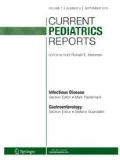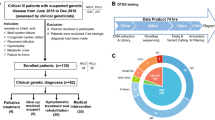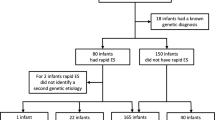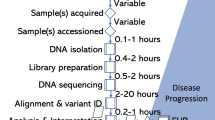Abstract
Purpose of Review
We highlight the evolving clinical application of genomic sequencing in caring for critically ill infants and children in the intensive care unit.
Recent Findings
As turnaround times for genetic sequencing continue to decrease, the application of this technology in caring for critically ill infants and children has correspondingly increased. Not only are clinicians now using genetic sequencing to make formal diagnoses in medically complex patients, but they are also using this information to inform recommendations regarding potential treatments and anticipate patient outcomes. Importantly, its application not only stands to impact clinical care, but may also streamline health care utilization.
Summary
Genomic sequencing is a powerful technology with clear clinical application in the neonatal and pediatric ICU settings. In addition to aiding in the diagnostic evaluation of critically ill children with suspected monogenic disorders, it has a clear impact on clinical decision-making and can improve family-centered care.
Similar content being viewed by others
References
Papers of particular interest, published recently, have been highlighted as: • Of importance •• Of major importance
• Willig LK, et al. Whole-genome sequencing for identification of Mendelian disorders in critically ill infants: a retrospective analysis of diagnostic and clinical findings. Lancet Respir Med. 2015;3(5):377–87 An interesting retrospective study that examines the clinical utility of genomic sequencing in critically ill infants.
Petrikin JE, Willig LK, Smith LD, Kingsmore SF. Rapid whole genome sequencing and precision neonatology. Semin Perinatol. 2015;39(8):623–31.
Saunders CJ, et al. Rapid whole-genome sequencing for genetic disease diagnosis in neonatal intensive care units. Sci Transl Med. 2012;4(154):154ra135.
Soden SE, Saunders CJ, Willig LK, Farrow EG, Smith LD, Petrikin JE, et al. Effectiveness of exome and genome sequencing guided by acuity of illness for diagnosis of neurodevelopmental disorders. Sci Transl Med. 2014;6(265):265ra168.
Olshan AF, Hobbs CA, Shaw GM. Discovery of genetic susceptibility factors for human birth defects: an opportunity for a National Agenda. Am J Med Genet A. 2011;155a(8):1794–7.
• Smith LD, Willig LK, Kingsmore SF. Whole-exome sequencing and whole-genome sequencing in critically ill neonates suspected to have single-gene disorders. Cold Spring Harb Perspect Med. 2015;6(2):a023168 A comprehensive review of genomic sequencing in critically ill infants.
•• Borghesi A, et al. Intersociety policy statement on the use of whole-exome sequencing in the critically ill newborn infant. Ital J Pediatr. 2017;43(1):100 A policy statement on the use of genomic sequencing in critically ill infants.
Miller DT, et al. Consensus statement: chromosomal microarray is a first-tier clinical diagnostic test for individuals with developmental disabilities or congenital anomalies. Am J Hum Genet. 2010;86(5):749–64.
Stamouli S, Anderlid BM, Willfors C, Thiruvahindrapuram B, Wei J, Berggren S, et al. Copy number variation analysis of 100 twin pairs enriched for neurodevelopmental disorders. Twin Res Hum Genet. 2018;21(1):1–11.
Bamshad MJ, Ng SB, Bigham AW, Tabor HK, Emond MJ, Nickerson DA, et al. Exome sequencing as a tool for Mendelian disease gene discovery. Nat Rev Genet. 2011;12(11):745–55.
Ng SB, Turner EH, Robertson PD, Flygare SD, Bigham AW, Lee C, et al. Targeted capture and massively parallel sequencing of 12 human exomes. Nature. 2009;461(7261):272–6.
Belkadi A, Bolze A, Itan Y, Cobat A, Vincent QB, Antipenko A, et al. Whole-genome sequencing is more powerful than whole-exome sequencing for detecting exome variants. Proc Natl Acad Sci U S A. 2015;112(17):5473–8.
Tetreault M, Bareke E, Nadaf J, Alirezaie N, Majewski J. Whole-exome sequencing as a diagnostic tool: current challenges and future opportunities. Expert Rev Mol Diagn. 2015;15(6):749–60.
Srivastava S, Cohen JS, Vernon H, Barañano K, McClellan R, Jamal L, et al. Clinical whole exome sequencing in child neurology practice. Ann Neurol. 2014;76(4):473–83.
• Meng L, Pammi M, Saronwala A, Magoulas P, Ghazi AR, Vetrini F, et al. Use of exome sequencing for infants in intensive care units: ascertainment of severe single-gene disorders and effect on medical management. JAMA Pediatr. 2017;171(12):e173438 An elegant study that examines the impact of exome sequencing on critical care management.
•• Petrikin, J.E., Cakici J.A., Clark M.M., Willig L.K., Sweeney N.M., Farrow E.G., Saunders C.J., Thiffault I., Miller N.A., Zellmer L., Herd S.M., Holmes A.M., Batalov S., Veeraraghavan N., Smith L.D., Dimmock D.P., Leeder J.S., Kingsmore S.F., The NSIGHT1-randomized controlled trial: rapid whole-genome sequencing for accelerated etiologic diagnosis in critically ill infants. NPJ Genom Med, 2018. 3: p. 6. A randomized control trial examining the diagnostic yield of expedited genomic sequencing in critically ill pediatric patients
Deverka PA, Kaufman D, McGuire AL. Overcoming the reimbursement barriers for clinical sequencing. JAMA. 2014;312(18):1857–8.
• Adams DR, Eng CM. Next-generation sequencing to diagnose suspected genetic disorders. N Engl J Med. 2019;380(2):201 A landmark paper outlining the application of next-generation sequencing modalities to suspected monogenic diseases.
• Farnaes, L., Hildreth A., Sweeney N.M., Clark M.M., Chowdhury S., Nahas S., Cakici J.A., Benson W., Kaplan R.H., Kronick R., Bainbridge M.N., Friedman J., Gold J.J., Ding Y., Veeraraghavan N., Dimmock D., Kingsmore S.F., Rapid whole-genome sequencing decreases infant morbidity and cost of hospitalization. NPJ Genom Med, 2018. 3: p. 10. An elegant paper that evaluates the clinical utility of expedited genomic sequencing and inpatient hospital cost.
Stark Z, Schofield D, Alam K, Wilson W, Mupfeki N, Macciocca I, et al. Prospective comparison of the cost-effectiveness of clinical whole-exome sequencing with that of usual care overwhelmingly supports early use and reimbursement. Genet Med. 2017;19(8):867–74.
Author information
Authors and Affiliations
Corresponding author
Ethics declarations
Conflict of Interest
The authors declare that they have no conflict of interest.
Human and Animal Rights and Informed Consent
This article does not contain any studies with human or animal subjects performed by any of the authors.
Additional information
Publisher’s Note
Springer Nature remains neutral with regard to jurisdictional claims in published maps and institutional affiliations.
This article is part of the Topical Collection on Intensive Care Medicine
Rights and permissions
About this article
Cite this article
Carey, A.S., Chung, W.K. Genomic Sequencing for Infants and Children in Intensive Care Units. Curr Pediatr Rep 7, 78–82 (2019). https://doi.org/10.1007/s40124-019-00196-3
Published:
Issue Date:
DOI: https://doi.org/10.1007/s40124-019-00196-3




